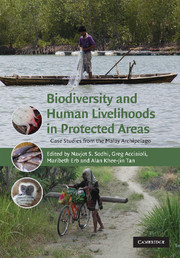Book contents
- Frontmatter
- Contents
- List of contributors
- Acknowledgements
- 1 General introduction
- Part I Conservation needs and priorities
- Part II Conservation with and against people(s)
- 11 Introduction to Part II
- 12 Collaboration, conservation, and community: a conversation between Suraya Afiff and Celia Lowe
- 13 Hands off, hands on: communities and the management of national parks in Indonesia
- 14 Conservation and conflict in Komodo National Park
- 15 Another way to live: developing a programme for local people around Tanjung Puting National Park, Central Kalimantan
- 16 For the people or for the trees? A case study of violence and conservation in Ruteng Nature Recreation Park
- 17 Seas of discontent: conflicting knowledge paradigms within Indonesia's marine environmental arena
- 18 Strategy and subjectivity in co-management of the Lore Lindu National Park (Central Sulawesi, Indonesia)
- 19 Indigenous peoples and parks in Malaysia: issues and questions
- 20 Protecting Chek Jawa: the politics of conservation and memory at the edge of a nation
- 21 Integrating conservation and community participation in protected-area development in Brunei Darussalam
- 22 Conclusion to Part II
- Part III Legal and governance frameworks for conservation
- 29 General conclusion
- Index
- References
15 - Another way to live: developing a programme for local people around Tanjung Puting National Park, Central Kalimantan
from Part II - Conservation with and against people(s)
Published online by Cambridge University Press: 12 November 2009
- Frontmatter
- Contents
- List of contributors
- Acknowledgements
- 1 General introduction
- Part I Conservation needs and priorities
- Part II Conservation with and against people(s)
- 11 Introduction to Part II
- 12 Collaboration, conservation, and community: a conversation between Suraya Afiff and Celia Lowe
- 13 Hands off, hands on: communities and the management of national parks in Indonesia
- 14 Conservation and conflict in Komodo National Park
- 15 Another way to live: developing a programme for local people around Tanjung Puting National Park, Central Kalimantan
- 16 For the people or for the trees? A case study of violence and conservation in Ruteng Nature Recreation Park
- 17 Seas of discontent: conflicting knowledge paradigms within Indonesia's marine environmental arena
- 18 Strategy and subjectivity in co-management of the Lore Lindu National Park (Central Sulawesi, Indonesia)
- 19 Indigenous peoples and parks in Malaysia: issues and questions
- 20 Protecting Chek Jawa: the politics of conservation and memory at the edge of a nation
- 21 Integrating conservation and community participation in protected-area development in Brunei Darussalam
- 22 Conclusion to Part II
- Part III Legal and governance frameworks for conservation
- 29 General conclusion
- Index
- References
Summary
Introduction
Managing natural resources is indispensable if they are to be used, while at the same time maintaining their sustainability. Usage should only be undertaken if the sustainability of the natural resource is firmly assured (Sayer & Campbell 2004). As a consequence, every consumption of a resource has to be carried out simultaneously with an act of conservation to ensure its continuation. This ideal principle often goes against the principle of economic investment, however, wherein the goal is to acquire the highest profit possible in return for the lowest possible expenditure. To balance the damage done to natural resources due to greed, strategies to regulate the utilization of natural resources are crucial.
The management of natural resources is highly relevant to the actors whose lives depend on these resources. In the context of natural resources in the form of forests, usage of the forest is carried out in accordance with local regulations, which are applicable to the local actors, and national laws, which control not only the locals, but outsiders and investors external to the region. Political ecologists have shown how the natural resources in particular places (Hecht 1985; Dodds 1998), including Indonesia (Peluso 1992), are of interest to outsiders, not just regionally and nationally, but also internationally. The resulting depletion of natural resources and the environment must then be analyzed in a broader context (Blaikie 1985; Robbins 2004).
- Type
- Chapter
- Information
- Biodiversity and Human Livelihoods in Protected AreasCase Studies from the Malay Archipelago, pp. 203 - 221Publisher: Cambridge University PressPrint publication year: 2007



